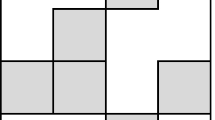Abstract
We study substitutive systems generated by nonprimitive substitutions and show that transitive subsystems of substitutive systems are substitutive. As an application we obtain a complete characterisation of the sets of words that can appear as common factors of two automatic sequences defined over multiplicatively independent bases. This generalises the famous theorem of Cobham.
Similar content being viewed by others
References
B. Adamozewski and J. P. Bell: Function fields in positive characteristic: expansions and Cobham’s theorem, J. Algebra 319 (2008), 2337–2350.
B. Adamczewski and J. P. Bell: An analogue of Cobham’s theorem for fractals, Trans. Amer. Math. Soc. 363 (2011), 4421–4442.
B. Adamczewski and J. P. Bell: A problem about Mahler functions, Ann. Sc. Norm. Super. Pisa Cl. Sci. 17 (2017), 1301–1355.
J.-P. Allouche, N. Rampersad and J. Shallit: Periodicity, repetitions, and orbits of an automatic sequence, Theoret. Comput. Sci. 410 (2009), 2795–2803.
J.-P. Allouche and J. Shallit: Automatic sequences, Cambridge University Press, Cambridge, 2003, Theory, applications, generalizations.
J.-P. Allouche and J. Shallit: A variant of Hofstadter’s sequence and finite automata, J. Aust. Math. Soc. 93 (2012), 1–8.
J. P. Bell: A generalization of Cobham’s theorem for regular sequences, Sém. Lothar. Combin. 54A (2005/07), Art. B54Ap. 15.
V. Berthé, W. Steiner, J. M. Thuswaldner and R. Yassawi: Recognizability for sequences of morphisms, Ergodic Theory and Dynamical Systems 39 (2019), 2896–2931.
S. Bezuglyi, J. Kwiatkowski and K. Medynets: Aperiodic substitution systems and their Bratteli diagrams, Ergodic Theory Dynam. Systems 29 (2009), 37–72.
B. Boigelot and J. Brusten: A generalization of Cobham’s theorem to automata over real numbers, Theoret. Comput. Sci. 410 (2009), 1694–1703.
B. Boigelot, J. Brusten and V. Bruyère: On the sets of real numbers recognized by finite automata in multiple bases, Log. Methods Comput. Sci. 6 (2010), 1–17.
B. Boigelot, J. Brusten and J. Leroux: A generalization of Semenov’s theorem to automata over real numbers, Automated deduction - CADE-22, Lecture Notes in Comput. Sci., vol. 5663, Springer, Berlin, 2009, 469–484.
V. Bruyère, G. Hansel, Ch. Michaux and R. Villemaire: Logic and p-recognizable sets of integers, Bull. Belg. Math. Soc. Simon Stevin 1 (1994), 191–238, Journées Montoises (Mons, 1992).
J. Byszewski and J. Konieczny: A density version of Cobham’s theorem, Acta Arith. 192 (2020), 235–247.
E. Charlier, J. Leroy and M. Rigo: An analogue of Cobham’s theorem for graph directed iterated function systems, Adv. Math. 280 (2015), 86–120.
G. Christol: Ensembles presque périodiques k-reconnaissables, Theoret. Comput. Sci. 9 (1979), 141–145.
A. Cobham: On the base-dependence of sets of numbers recognizable by finite automata, Math. Systems Theory 3 (1969), 186–192.
A. Cobham: Uniform tag sequences, Math. Systems Theory 6 (1972), 164–192.
J. D. Currie, N. Rampersad, K. Saari and L. Q. Zamboni: Extremal words in morphic subshifts, Discrete Math. 322 (2014), 53–60.
F. Durand: Cobham’s theorem for substitutions, J. Eur. Math. Soc. (JEMS) 13 (2011), 1799–1814.
F. Durand and M. Rigo: On Cobham’s theorem, (2011), https://hal.archives-ouvertes.fr/hal-00605375.
M. Einsiedler and T. Ward: Ergodic theory with a view towards number theory, Graduate Texts in Mathematics, vol. 259, Springer-Verlag London, Ltd., London, 2011.
M. Elekes, T. Keleti and A. Máthé: Self-similar and self-affine sets: measure of the intersection of two copies, Ergodic Theory Dynam. Systems 30 (2010), 399–440.
R. Ellis: Distal transformation groups, Pacific J. Math. 8 (1958), 401–405.
J.-H. Evertse and K. Győry: Unit equations in Diophantine number theory, Cambridge Studies in Advanced Mathematics, vol. 146, Cambridge University Press, Cambridge, 2015.
I. Fagnot: Sur les facteurs des mots automatiques, Theoret. Comput. Sci. 172 (1997), 67–89.
D.-J. Feng and Y. Wang: On the structures of generating iterated function systems of Cantor sets, Adv. Math. 222 (2009), 1964–1981.
J. Honkala: A decision method for the recognizability of sets defined by number systems, RAIRO Inform. Théor. Appl. 20 (1986), 395–403.
K. S. Kedlaya: Finite automata and algebraic extensions of function fields, J. Theor. Nombres Bordeaux 18 (2006), 379–420.
K. Klouda: and S. Starosta: An algorithm for enumerating all infinite repetitions in a D0L-system, J. Discrete Algorithms 33 (2015), 130–138.
S. Lang: Integral points on curves, Publ. Math. Inst. Hautes Etudes Sci. 6 (1960), 27–43.
M. Lothaire: Combinatorics on words, Cambridge Mathematical Library, Cambridge University Press, Cambridge, 1997.
M. Lothaire: Algebraic combinatorics on words, Encyclopedia of Mathematics and its Applications, vol. 90, Cambridge University Press, Cambridge, 2002.
K. Mahler: Zur Approximation algebraischer Zahlen. I, Math. Ann. 107 (1933), 691–730.
G. R. Maloney and D. Rust: Beyond primitivity for one-dimensional substitution subshifts and tiling spaces, Ergodic Theory Dynam. Systems 38 (2018), 1086–1117.
L. Mol, N. Rampersad, J. Shallit and M. Stipulanti: Cobham’s theorem and automaticity, Internat. J. Found. Comput. Sci. 30 (2019), 1363–1379.
M. Queffélec: Substitution dynamical systems - spectral analysis, second ed., Lecture Notes in Mathematics, vol. 1294, Springer-Verlag, Berlin, 2010.
G. Rozenberg and A. Salomaa: The mathematical theory of L systems, Pure and Applied Mathematics, vol. 90, Academic Press, Inc. [Harcourt Brace Jovanovich, Publishers], New York-London, 1980.
R. Schäfke and M. F. Singer: Mahler equations and rationality, (2017), Preprint. arXiv:1605.08830 [math.CA].
A. L. Semenov: The Presburger nature of predicates that are regular in two number systems, Sibirsk. Mat. Ž. 18 (1977), 403–418.
Author information
Authors and Affiliations
Corresponding author
Rights and permissions
About this article
Cite this article
Byszewski, J., Konieczny, J. & Krawczyk, E. Substitutive Systems and a Finitary Version of Cobham’s Theorem. Combinatorica 41, 765–801 (2021). https://doi.org/10.1007/s00493-020-4311-x
Received:
Revised:
Published:
Issue Date:
DOI: https://doi.org/10.1007/s00493-020-4311-x




